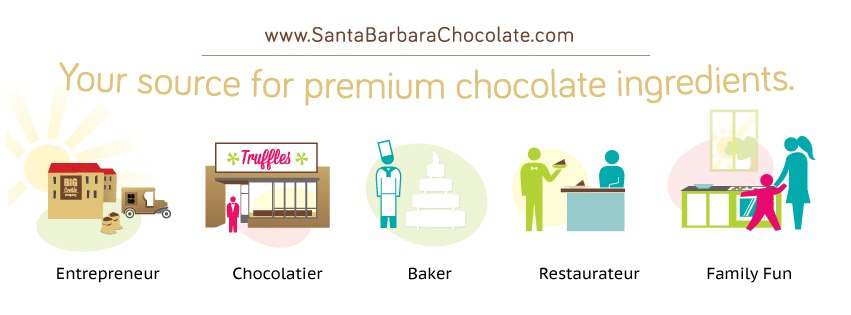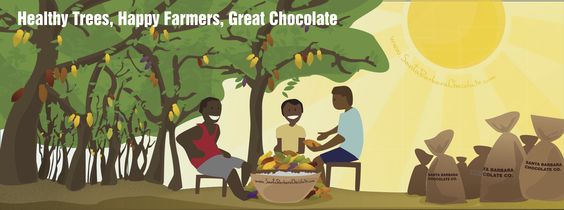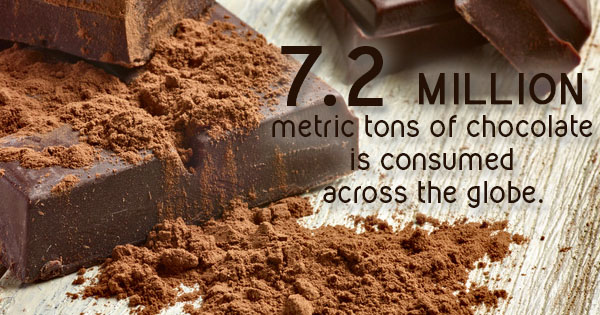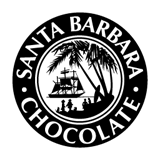
120 YEARS OF QUALITY CHOCOLATE PRODUCTS
Cacao and Cocoa Bean Flavors
Since 1992, Santa Barbara Chocolate has been producing a variety of cocoa and chocolates. For over 120 years, our farm partners and suppliers have been growing quality cacao. Known as a chocolate specialist, Santa Barbara Chocolate's reputation is built upon excellent quality. Our name is a name that dances on the tongue, conjuring up the top quality image of pure chocolate.
The cocoa beans we use in making our pure cacao and chocolate products have to pass through a series of in depth processes. From harvesting to the manufacture of chocolate liquor we watch the flavor development to ensure we make the best chocolate possible. Chocolate liquor, an unsweetened pure cacao chocolate with 100% cocoa solids is what we make from the cocoa beans. This chocolate liquor is then used to make other types of chocolates like milk chocolate or even truffles. As a partner in the cocoa processing, Santa Barbara Chocolate places significant importance on the sensory evaluation of chocolate liquor. The processes our pure cacao chocolate with 100% cocoa solids passes through is significant.

Sensory Evaluation of Chocolate Liquor at Santa Barbara Chocolate
We believe that flavor is everything when it comes to chocolate since tasteless chocolates are such a let down. As a result, we have employed the use of scientific concepts of sensory science and flavor chemistry to assist in making informed decisions regarding taste quality. Before manufacturing the different flavors and types of chocolate, chocolate liquor (the first ingredient of the chocolate making process) passes through phases of testing by our team of sensory analysis professionals. Keep in mind chocolate liquor, cocoa powder, chocolate powders are obtained from a very complex tree that produces pod fruit filled with seeds known as cocoa beans. Cocoa beans are ground to make the chocolate liquor mentioned above.
Since chocolate making began, manufacturers have been fascinated by the complexity of the cocoa seed. While over 500 flavor compounds of cocoa seed have been identified, coming up with the source of each has been complex. For many years chocolate processors have defined the flavors of the cocoa seed and the liquor it makes.These descriptions and concepts start from the harvesting phase to manufacturing stage.
Before cocoa beans (seeds) are processed, their flavor is examined to ensure consistency is maintained. For this reason, it is important for us to monitor the harvesting, transportation, and processing. In harvesting, growers should ensure that all conditions are favorable. Shipping conditions should be devoid of moisture. Cutting corners will result in a bad tasting chocolate Santa Barbara Chocolate works with suppliers on the quality of cocoa seeds. We also ensure that as the raw materials reach us; we store them in conducive temperatures to avoid growing of molds and changing of flavor.
Things Affecting Cocoa Beans and Chocolate Liquor
The flavor of both cocoa beans and chocolate liquor is affected by three main concepts, namely origin practices, storage, and processing conditions. Origin practices which is namely the growing season, weather during harvesting, and the farming practices employed affect the quality of cocoa beans. Depending on the season of planting and harvesting, cocoa plants vary in quality. The best quality is when cacao trees are planted in October and harvested around April (it can take up to 10 years on some trees to produce their first cocoa fruit). Cocoa planted outside these months, tend to be smaller, lower in cocoa butter fat, and poor quality. In short, they cannot produce the desired flavor requirements by the Santa Barbara Chocolate sensory team. We believe that healthy cocoa trees are imperative for the manufacture of organic chocolate. Making sure that the trees breath and the cocoa pods ripen to maximum flavor is an ingredient for quality organic chocolate.
The weather really affects cocoa bean quality and taste. In West Africa, crops are planted in October and harvested in either March or April. During these months, there is a trade wind from the North that reduces the temperatures. This creates a situation where the cocoa beans need to be kept for longer periods to allow for proper bean fermentation that resonates to good flavor and quality. Farmers who do not expose the cocoa beans to more extended periods of fermentation will have poor quality cocoa beans characterized by a gray color and astringent flavor. To promote company success, Santa Barbara Chocolate ensures that its cocoa beans are quality and obtained within the required months by using a professional audit team in the field.
Our third party audit teams watch the weather, harvesting and post harvesting practices like fermentation. The quality of cacao and cocoa beans vary by the type of soil pH and drainage. Good bean value is obtained from trees that are grown on deep, neutral and properly drained soil. There are three bean types generally recognized: Forastero, Criollo, and Trinitario. The Forastero is mainly grown in West Africa and Brazil, and it is known for its violet and flat pods. Criollo and Trinitario are known as flavor beans as they have a unique aromatic flavor of floral, strong fruit or even spice. These last two varieties mentioned are used to make different flavor chocolates while the African variety offers a classic fudge like flavor.
So, the post-harvest practices such as the length of fermentation and drying influence the flavor of beans. Storage and transportation conditions play a big part in obtaining and ensuring that the seeds that reach the factory are quality. While transporting, the storage should be clean and devoid of any smell. This will make sure that the cocoa seeds reach the chocolate factory in the same clean state as it was picked up from the farm. Once to the chocolate factory, the cocoa beans are stored in favorable conditions to avoid affecting chocolate liquor flavor.
Uniqueness of Chocolate Flavors in the World
The flavor of cocoa beans (cocoa seeds) can depend on the place it was grown, temperature, latitude, and the side of the equator it is found. Therefore, cocoa beans from a Latitude of 20° are different than those from a lower latitude region. The most important reasons of difference between and in origins can be accredited to variances in bean multiplicities, places they have been grown and come from, and methods used after harvesting, for instance, transporting. Furthermore, even if the cocoa seeds are in the same country, differences can be seen as a result of post-harvest handling. At Santa Barbara Chocolate we endeavor to ensure that irrespective of the place, we provide our clients with products that will ensure a continued quality and development of the best chocolate.

Fermentation of Flavors
Fermentation is one of the most important processes of processing cocoa beans. It involves a series of processes that use yeast and safe bacteria as the catalysts. The yeast and safe bacteria also become the primary flavor and components used to change cocoa bean color. The initial phase of fermentation is an anaerobic reaction, which entails the changing of sugars into ethanol through reducing pH of the beans. The processes usually take 24-36 hours. The anaerobic reaction evolves and becomes a full fermentation reaction. This procedure usually takes an additional 48-96 hours and involves the reaction between the lactic acid bacteria and the sugars. As this process continues, the cocoa beans pass through an exothermic reaction, which encompasses the release of heat.
While fermentation must be standard, it involves adjusting levels to match the proper requirements for the particular cacao variety. In general, lower level fermentation leads to different types of acidic flavors including astringency. It is characterized by compression or reduction of mouth tissues leading the taster to have a dry or fuzzy sensation. The second flavor is bitterness. The bitterness taste is roused by elements like quinine. The third flavor associated with little fermentation is green and grassy almost. It is characterized by the smell of freshly cut grass just like after you mow the lawn.
Higher level fermentation is characterized by flavors that range from acetic, cheesy, fermented fruit, putrid, sour, straw, and yeast. The acetic flavor is one that is defined by sweet-smelling pure white vinegar. Cheesy, on the other hand, is characterized by an aromatic flavor linked to vague acidic cheese. Fermented fruit is the sweet-smelling fruit note found in red wine. Putrid is an attribute of rotten fruit similar to rotten plum or apple. Sour flavors and acidity develop with longer fermentation. Straw flavor is a sweet smell that is related to dried grain stalks. Yeasty flavor is linked with yeast and products that have it. These flavors vary and are attributed with some of our pure cacao chocolates on occasion. Our sensory panelists always know how to differentiate between the astringency and bitterness flavors and study these when evaluating quality of the cacao. Please keep in mind fermentation and the resulting flavors varies widely from cacao type to type so these guides are generalized and must be adjusted for the cacao variety, country of origin and processes being used.
High Fermentation Flavor Attributes
When fermentation takes a long time, some flavor characteristics emerge. The first is Acetic, which is characterized by the aroma of distilled white vinegar. Secondly, there is the cheesy, which is linked to vague acidic cheese. Lengthy fermentation is also associated with the fermented fruit flavor, putrid, sour, straw, and yeasty.
Drying and Storage Flavors
Immediately after the beans have been fermented, they are passed through the drying process. Drying is an important procedure because it assists in reducing the moisture content in the cocoa beans, raising the pH, and decreasing astringency. The length of time usually depends on the kind of weather during post-harvest. Drying can be carried out using two primary techniques namely natural or mechanical procedures. Sun drying is the most preferred method. However, it depends on three main components which are the duration, labor, and the kind of weather. In countries that are mostly wet, mechanical drying is preferred as sun drying might lead to accumulation of moisture affecting been flavor and causing the growth of molds. Though Sun drying is the most favored, not many nations use it. Countries like Brazil, which produce large quantities of cocoa seeds, use mechanical methods of drying. Though it is the fastest, it causes loss of enzymes, and sometimes the high temperatures make the cocoa seeds brittle and give it a strong smoky flavor.
After drying the cocoa seeds, they are then transported or shipped to the market for export. Here, the state in which the seeds are stored also affect flavor notes like musty and meaty flavors. A musty flavor comes about when the seeds are stored in highly humid conditions where they end up developing molds. The Moldy cocoa seeds end up having increased levels of carbonyls, hence, the musty off note. A meaty flavor could come about when the dried cocoa seeds are stored under moist conditions or if they are dried over a flame (this is a common practice in Indonesia). Other types of flavors that may result from mechanical drying and storage are petroleum-like, smokey, and sulfury-rubber.
How Chocolate Liquor is processed
When the cocoa beans reach the factory, we take it through a procedure to create a chocolate product known as chocolate liquor. Chocolate liquor usually has a cocoa butter fat content of approximately 50-60%. The process of manufacturing is complicated, and it involves cleansing of the beans, separation of the nibs and shell through a process known as winnowing, roasting, and grinding. After grinding, we carry out the standardization of the cocoa fat. Through this processes, we can ensure the quality of chocolate liquor being produced.

Manufacturing of chocolate liquor is subject to processes that if altered can lead to big changes in flavor. The initial procedure, which involves cleaning and separation, is done in one dedicated room. Each cocoa bean type has its own dedicated compartment for storage to avoid mixing and creating of different flavors if it is accidently mixed with another cocoa bean type. The alkalization process when making cocoa powder, is done in an efficient and gentle alkalizing bath. The level of roast is the biggest final influencer on chocolate flavor (just like coffee roasting in this regard).
Processing Flavor
The different chocolate flavors created by roasting are some of the most important. Depending on the level or amount of roasting, the flavor varies significantly (just like in coffee roasting). Roasting is defined as the procedure that takes time at temperatures ranging from 110-150C.
Roasting assists in stopping the microbiological reactions. Flavor development is carried out by the Maillard reaction, which is the lessening of sugars and amino acids in the beans. The Maillard reaction leads to the development of different compounds such as acetaldehyde and pyrazines.
The method of roasting can be attributed to various forms of flavors. Depending on the manufacturer, two types of roasting can be used; continuous process and batch procedure roasting. The ongoing process involves the roasting of whole beans while the batch process entails roasting of the cocoa nib (cracked pieces of cocoa bean). Currently, most manufacturers usually oversee the roasting of nibs to attain micro reduction and uniform heating. While nib roasting is essential for micro reduction, whole bean procedures are used to get unique flavors. Flavors associated with low roast are fruity, floral, sour, and green/ grassy. Those associated with a high roast are ash and carbon and even earthy. However, when the cocoa beans are subjected to harsh, fast, super hot roasting conditions, they will bring out sulfury-rubber flavors.
The Need for Testing Chocolate Liquor
To further ensure quality and satisfaction of your needs and the chocolatier, Santa Barbara Chocolate follows strict and standard procedures when testing chocolate liquor used to make our chocolate products. Firstly, the liquefied state of chocolate is tasted at a temperature of 40-60C. This assists in the release of subtle flavors and aromas to savor the chocolate liquor fully. The chocolate is kept unsweetened so as to really study the nuances. After setting up the conditions for testing, Santa Barbara Chocolate has guided testing procedures that begin with the sensory analyst team tasting the warm chocolate liquor with a spoon. Samples are tested from left to right. They are organized from the least to most flavorful. In between the testing, the tasters clean their mouth using water and unsalted crackers. This is done to ensure that the taste buds are cleaned from the previous flavors. More so, the tasting panelists wait approximately five minutes to allow their palate to lose the last flavor. To ensure the quality of testing, Santa Barbara Chocolate only evaluates three samples per session. Furthermore, the company promotes quality by making sure that the tasting panelists are calibrated to their training. This is done through monthly blind control sessions that involve a chocolate liquor flavor wheel (Figure 1).
In Conclusion
Chocolate making is an art as well as a science. With over 120 years of experience, our partners and Santa Barbara Chocolate have been providing quality services and chocolate factory expertise and manufacturing. We have won the hearts of our followers through the various nuances and flavors or real chocolate. Looking keenly at the big picture of chocolate making, we use sophisticated sensory and flavor chemistry expertise to make the best chocolate in the world. We differentiate between the various chocolate flavors and look for ways to present the cacao at its best. Following the sensory system we discussed above offers an avenue for effective decision-making to ensure high quality chocolate. We utilize the tools of testing daily to make sure we always have a quality chocolate. Knowing the difference in raw cacao materials and cocoa bean processing ensures chocolate that tastes good. The commitment of our consumers and clients like you, is to demand more of us, and so we must ensure that our chocolate products and flavors satisfy your needs

